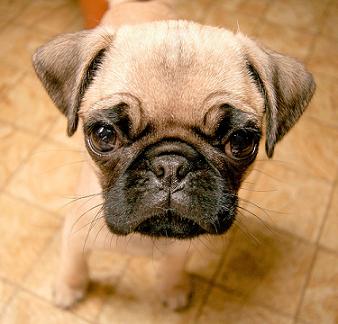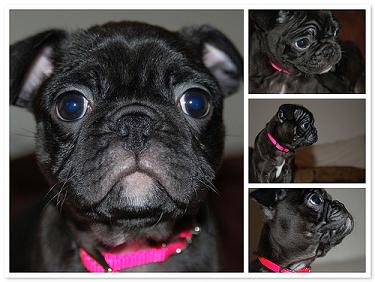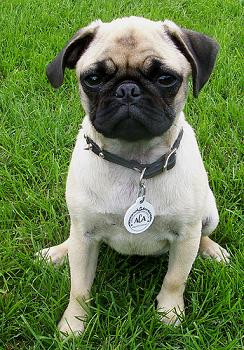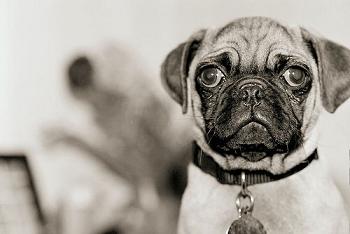Pug Puppy Training & Breed Information
Go straight down to Pug Puppy Training Information
Pug Puppies are considered a toy dog breed - but don't be fooled!
A Pug puppy is a whole lot of dog in a small package. Pugs are chock-full of clownish personality, mischievous character and playful spunk. Pugs are also highly affectionate people oriented dogs who crave human companionship. And of course they are one of the cutest of all dog breeds!

Pug Puppy History
These great little dogs are more than 1000 years old. Pugs originated in the Orient where they were the breed of choice for Chinese Emperors. From China they spread to Holland, then England and are now an extremely popular human companion breed right across the globe.Pugs were first registered by the American Kennel Club in 1885.
Pug Puppy Appearance & Size
Pug puppies are much loved for their cute monkey like face which is distinctive for its wrinkly appearance and ever changing expression. Plus they have those lovely big round eyes that peer up at you.The other distinctive feature of the Pug is their tail which curls up tightly above their backs.
When given proper nutrition and exercise a Pug puppy is a well balanced, muscular and powerful little package. They have a short but glossy double coat which comes in black and various shades of fawn. Pugs do shed so it's important to brush your dog every few days in order to minimize the shedding. A Pug's mask and ears are most often black.
A healthy and fully grown Pug stands at between 10 to 14 inches tall at the shoulder and weighs about 15 to 20 pounds. They are a beautiful sight.

Pugs - The All Important Temperament
Pugs have a lovely outgoing personality. When well bred, socialized and trained Pugs have a stable, even temperament which is well suited to families with children.To give yourself the best chance of bringing a physically and mentally sound Pug puppy into your life it is essential that you purchase your puppy from a reputable Pug puppy breeder. A good Pug breeder will have the health and wellbeing of the breed at the forefront of every decision they make. They will not be motivated by your money.
A few general points regarding the temperament and characteristics of a Pug puppy:
- Pugs can experience a long puppyhood which lasts up to 2 years. After this period they settle down to become a relatively low maintenance and sensible companion. This makes them a good choice for apartment dwellers and for dog lovers who don't have the time to exercise a very active dog.
- As I mentioned earlier Pugs thrive on human companionship. They are very sociable, loyal and affectionate towards their human family and do not do well when separated for long periods. As a result some Pugs do suffer from separation anxiety. Pugs are an indoor dog breed who expect to be involved in all family activities!
- Pugs make good little watchdogs. They have a deep loud bark which sounds like it should belong to a much larger dog. You'll find your Pug will sound his/her warning bark at any disturbance around your home. Pugs are not mad or nuisance barkers.
- Puppy socialization and training are the crucial ingredients which combine to shape the temperament and behavior habits of your Pug. All dogs regardless of breed type need to be given at least some basic training.
- Generally speaking Pugs have a happy easy going disposition but they also possess a stubborn independent streak at times.

Pug Puppy Health Information
Pugs are not without their health problems. once again if you purchase your Pug puppy from a reputable Pug breeder you can drastically reduce the risk of many of the health concerns listed below. Finding a good Pug breeder is well worth your time and effort. With any luck your Pug will live a happy and healthy 12 years of age.Your Veterinarian and Pug breeder are the best people to go to for specific Pug health care advice. For your information I have listed some of the more common problems below:
- The shortened muzzle of the Pug can cause many breathing difficulties. Heat and humidity compound the breathing problems even more. For this reason Pugs do best in a nice mild climate - not too hot and not too cold.
- Be careful with the large bulging eyes of your Pug - these are easily damaged. Eyes should also be checked for cataracts which can affect Pugs as they get older.
- The facial folds on your Pug add much charm and character but they do require regular washing. Clean the face folds out with a suitable solution mixed with water - be sure to dry after cleaning.
- Canine Obesity is a growing problem with Pugs. This is something you are in control of through the quality and quantity of food you provide and also the exercise you provide. An overweight Pug is an unhealthy Pug.
- As your Pug gets older it is important that you keep their teeth and gums clean - this is especially true if you do not feed any raw bones.
- Pugs also suffer from Patella Luxation, Hip Dysplasia, Legg Perthes, Encephalitis and Progressive Retinal Atrophy.
Pug Puppy Training Information
Let's be honest here - Pug puppies are not the easiest dogs to train. They have a stubborn independent streak and can be strong-willed little beasts. When training your Pug puppy it is important that you start as early as possible. As soon as your puppy arrives home you should begin establishing desirable behavior habits while at the same time preventing problem behaviors before they arise.Pugs respond best to positive, gentle and reward based training methods - the key is to make training sessions enjoyable and worthwhile for your Pug puppy. Use plenty of encouragement, praise and repetition in your training and try to focus on reinforcing desirable behavior rather than punishing what you consider to be bad behavior. Always be fair, consistent and show proper guidance to your Pug and he/she will respond brilliantly.
Some of the more common training issues Pug owners encounter are:
- Pug house training or potty training is one of the first issues you will need to get right. It should be said that Pugs are not the easiest dogs to house train. They have a small bladder and "accidents" are common place. My advice would be to pick out a proven Pug house training schedule and follow it with consistency and patience.
Your goal is to prevent as many house training "accidents" as possible and always reward desirable eliminations. You can find a good Pug puppy housebreaking schedule outlined step-by-step in the training resource listed below. Many Pug owners favor the use of a crate in the house training process.
- Your Pug puppy will need to be taught proper household etiquette right from day 1. This includes such things as chew toy training, keeping off the furniture and preventing food stealing. It's always better to prevent these behaviors from arising rather than trying to rectify established problem behaviors.
- Pug puppy socialization is also a must. Your Pug breeder will begin this process, then it is up to you to continue it as soon as your puppy arives home. Puppy socialization helps to shape your dog into a well respected, sound and trusted member of society. You can read more about the socialization process here - Pug socialization process.
- All the basic obedience training commands such as sit, down, heel, stay, come and stand are easily learned by a Pug puppy. These commands should be taught to all dogs for their physical and mental stimulation and also for safety reasons. The "come" command is a particularly important one for Pug puppies - it may save your dog's life one day.
- Pug puppies grow to be a strong powerful little package. Therefore it is essential to train your Pug to walk nicely on a loose leash. Once again you will find the proper way to leash train your Pug in the training resource listed below.
Most importantly remember to have fun in your training sessions. Keep them short, intense and make them rewarding for your Pug. You'll find that time spent training your Pug is time well spent - it's where you will develop and strengthen the close bond you will enjoy with your Pug puppy.
You will find more detailed and specific Pug training advice within this great Pug training resource - Pug Dog Secrets Training Package

Please consult the services of a Professional Dog Trainer, Behaviorist or Veterinarian before implementing any of the advice contained on this site.









